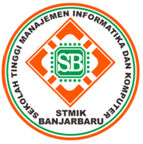Penerapan Teknologi Augmented Reality Untuk Edukasi Hewan Purbakala Dengan Metode Marker Tracking Pada Snapchat
Abstract
Ancient animals are animals that existed in the past and are now extinct, the remains of which are bones called fossils. The introduction of ancient animals so far still uses books that seem boring in the form of pictures, two dimensions, paintings and other props. This is felt to be less effective, it seems not interactive, it only looks at one side, so it needs education that is more interesting, fun and looks real. This research aims to introduce interactive, interesting, innovative ancient animals that are expected to be able to provide an easy experience in recognizing ancient animals that lived in prehistoric times into more real-time characters. The methodology in its development uses the Multimedia Development Life Cycle (MDLC) the steps consist of concept, design, material collecting, assembly, testing, distribution. The results of this study succeeded in displaying 3-dimensional objects in the form of ancient animals as interactive, interesting, innovative, practical, valid, effective ancient animal recognition media. The test results on several versions of Android in the form of image objects have a high degree of accuracy.
Keywords: Augmented Reality Technology; Ancient Animals; Marker Based Tracking
Â
Abstrak
Hewan purbakala merupakan hewan yang sudah ada masa lampau dan sekarang sudah punah peninggalannya berupa tulang yang disebut fosil. Pengenalan hewan purbakala selama ini masih menggunakan buku terkesan membosankan berbentuk gambar, dua dimensi, lukisan dan alat peraga lain, Hal ini dirasa kurang efektif terkesan tidak interaktif hanya dilihat pada suatu sisi saja, sehingga perlu edukasi yang lebih menarik, menyenangkan, dan terlihat seperti nyata. Penelitian ini bertujuan untuk mengenalkan hewan purba yang interaktif, menarik, inovatif diharapkan mampu memberikan pengalaman kemudahan dalam mengenali hewan purba yang hidup pada zaman prasejarah kedalam karakter yang real time lebih nyata. Metodologi dalam pengembangannya menggunakan Multimedia Development Life Cycle (MDLC) langkah-langkahnya terdiri dari concept, design, material collecting, assembly, testing, distribution. Hasil penelitian ini berhasil menampilkan objek 3 dimensi berupa hewan purba sebagai media pengenalan hewan purba interaktif, menarik, inovatif, efektif dan praktis. Hasil pengujian pada beberapa versi android berupa objek gambar memiliki tingkat keakuratan yang tinggi.
Kata Kunci: Teknologi Augmented Reality; Hewan Purba; Marker Based Tracking
References
E. Kennedy Thornton and K. F. Emery, “Patterns of ancient animal use at El Mirador: evidence for subsistence, ceremony and exchange,†2016.
A. Tarriño, I. Elorrieta, and M. GarcÃa-Rojas, “Flint as raw material in prehistoric times: Cantabrian Mountain and Western Pyrenees data,†Quaternary International, vol. 364, pp. 94–108, Apr. 2015, doi: 10.1016/j.quaint.2014.10.061.
M. M. Zarzuela, F. J. D. Pernas, L. B. MartÃnez, D. G. Ortega, and M. A. RodrÃguez, “Mobile serious game using augmented reality for supporting children’s learning about animals,†in Procedia Computer Science, vol. 25, pp. 375–381, 2013. doi: 10.1016/j.procs. 2013.11.046.
B. Regassa Hunde and A. Debebe Woldeyohannes, “Future prospects of computer-aided design (CAD) – A review from the perspective of artificial intelligence (AI), extended reality, and 3D printing,†Results in Engineering, vol. 14, p. 100478, Jun. 2022, doi: 10.1016/J.RINENG.2022.100478.
S. Vasilis, N. Nikos, and A. Kosmas, “An Augmented Reality Framework for Visualization of Internet of Things Data for Process Supervision in Factory Shop-Floor,†in Procedia CIRP, 2022, vol. 107, pp. 1162–1167. doi: 10.1016/j.procir.2022.05.125.
C. L. Chiu, H. C. Ho, T. Yu, Y. Liu, and Y. Mo, “Exploring information technology success of Augmented Reality Retail Applications in retail food chain,†Journal of Retailing and Consumer Services, vol. 61, Jul. 2021, doi: 10.1016/j.jretconser.2021.102561.
A. Javornik et al., “‘What lies behind the filter?’ Uncovering the motivations for using augmented reality (AR) face filters on social media and their effect on well-being,†Comput Human Behav, vol. 128, p. 107126, Mar. 2022, doi: 10.1016/J.CHB.2021.107126.
T. Teo, S. Khazaie, and A. Derakhshan, “Exploring teacher immediacy-(non) dependency in the tutored augmented reality game-assisted flipped classrooms of English for medical purposes comprehension among the Asian students,†Comput Educ, vol. 179, p. 104406, Apr. 2022, doi: 10.1016/J.COMPEDU.2021.104406.
C. J. McCarthy and R. N. Uppot, “Advances in Virtual and Augmented Reality—Exploring the Role in Health-care Education,†J Radiol Nurs, vol. 38, no. 2, pp. 104–105, Jun. 2019, doi: 10.1016/J.JRADNU.2019.01.008.
N. Norouzi, K. Kim, G. Bruder, J. N. Bailenson, P. Wisniewski, and G. F. Welch, “The advantages of virtual dogs over virtual people: Using augmented reality to provide social support in stressful situations,†Int J Hum Comput Stud, vol. 165, p. 102838, Sep. 2022, doi: 10.1016/J.IJHCS.2022.102838.
G. Kipper, “The Value of Augmented Reality: Public Safety, The Military, and The Law,†Augmented Reality, pp. 97–109, Jan. 2013, doi: 10.1016/B978-1-59-749733-6.00004-8.
Z. He, L. Wu, and X. (Robert) Li, “When art meets tech: The role of augmented reality in enhancing museum experiences and purchase intentions,†Tour Manag, vol. 68, pp. 127–139, Oct. 2018, doi: 10.1016/J.TOURMAN.2018.03.003.
T. L. Huang, “Restorative experiences and online tourists’ willingness to pay a price premium in an augmented reality environment,†Journal of Retailing and Consumer Services, vol. 58, p. 102256, Jan. 2021, doi: 10.1016/J.JRETCONSER.2020.102256.
N. N. Stone et al., “Remote surgical education using synthetic models combined with an augmented reality headset,†Surg Open Sci, vol. 10, pp. 27–33, Oct. 2022, doi: 10.1016/J.SOPEN.2022.06.004.
D. Mourtzis, V. Samothrakis, V. Zogopoulos, and E. Vlachou, “Warehouse Design and Operation using Augmented Reality technology: A Papermaking Industry Case Study,†Procedia CIRP, vol. 79, pp. 574–579, Jan. 2019, doi: 10.1016/J.PROCIR.2019.02.097.
E. Cieza and D. Lujan, “Educational Mobile Application of Augmented Reality Based on Markers to Improve the Learning of Vowel Usage and Numbers for Children of a Kindergarten in Trujillo,†Procedia Comput Sci, vol. 130, pp. 352–358, Jan. 2018, doi: 10.1016/J.PROCS.2018.04.051.
H. Mitsuhara, C. Tanimura, J. Nemoto, and M. Shishibori, “Expressing Disaster Situations for Evacuation Training Using Markerless Augmented Reality,†Procedia Comput Sci, vol. 192, pp. 2105–2114, Jan. 2021, doi: 10.1016/J.PROCS.2021.08.218.
R. Moreta-MartÃnez, I. Rubio-Pérez, M. GarcÃa-Sevilla, L. GarcÃa-Elcano, and J. Pascau, “Evaluation of optical tracking and augmented reality for needle navigation in sacral nerve stimulation,†Comput Methods Programs Biomed, vol. 224, p. 106991, Sep. 2022, doi: 10.1016/J.CMPB.2022.106991.
M. E. Apriyani, R. Gustianto, J. T. Multimedia, D. Jaringan, P. N. Batam, and P. B. Centre, “Augmented Reality sebagai Alat Pengenalan Hewan Purbakala dengan Animasi 3D menggunakan Metode Single Marker,†Jurnal Infotel, vol. 7, no. 1, pp. 47-52, 2015.
F. Aji Purnomo, S. Alim Tri Bawono, and R. Irianti, “Pembuatan Aredu Sebagai Media Pembelajaran Peninggalan Manusia Purba Di Sangiran,†Indonesian Journal of Applied Informatics, vol. 1, no. 1, pp. 99-110, 2016.
A.K. Mufida and M. Harun, “Aplikasi Pengenalan Hewan Lindung Menggunakan Augmented Reality Dengan Metode Marker Based Tracking,†Journal of Digital Education, Communication, and Arts (DECA), vol. 1, no. 1, pp. 34-43. 2018.
S. D. Riskiono, T. Susanto, and K. Kristianto, “Augmented reality sebagai Media Pembelajaran Hewan Purbakala,†Krea-TIF, vol. 8, no. 1, p. 8, pp. 8-18, May 2020, doi: 10.32832/kreatif.v8i1.3369.
E. Dwi Fransiska, T. Mohammad Akhriza, and L. Asih primandari, “Implementasi Teknologi Augmented Reality Sebagai Media Pembelajaran Informatif Dan Interaktif Untuk Pengenalan Hewan,†In Seminar Nasional Sistem Informasi (SENASIF), Vol. 1, pp. 636-645, 2017.
F. N. Kumala, A. Ghufron, P. P. Astuti, M. Crismonika, M. N. Hudha, and C. I. R. Nita, “MDLC model for developing multimedia e-learning on energy concept for primary school students,†in Journal of Physics: Conference Series, Apr. 2021, vol. 1869, no. 1, p. 012068, doi: 10.1088/1742-6596/1869/1/012068.
M. E. Apriyani, R. Gustianto, J. T. Multimedia, D. Jaringan, P. N. Batam, and P. B. Centre, “Augmented Reality sebagai Alat Pengenalan Hewan Purbakala dengan Animasi 3D menggunakan Metode Single Marker,†Jurnal Infotel, vol. 7, no. 1, pp. 47-52, 2015.
L. and I. G. N. S. Calvin, “Aplikasi Mengenal Hewan Purbakala Berbasis Augmented Reality dengan Metode Multi Marker,†CogITo Smart Journal, vol. 8, no. 1, pp. 259–270, Jun. 2022.
P. S. A. S. A. and I. D. S. Nuha, “Model Addie Pada Augmented Reality Hewan Purba Bersayap Menggunakan Algoritma Fast Corner Detection Dan Nft,†IPI (Jurnal Ilmiah Penelitian dan Pembelajaran Informatika), vol. 6, no. 2, pp. 178–186, Dec. 2021.
Y. A. and T. I. I. Saputra, “Implementasi augmented reality (AR) pada fosil purbakala di museum geologi Bandung.,†Jurnal Ilmiah Komputer dan Informatika, vol. 1, no. 1, pp. 1–8, Aug. 2014.
F. Aji Purnomo, S. Alim Tri Bawono, and R. Irianti, “Pembuatan Aredu Sebagai Media Pembelajaran Peninggalan Manusia Purba Di Sangiran,†Indonesian Journal of Applied Informatics, vol. 1, no. 1, pp. 99-110, 2016.
How To Cite This :
Refbacks
- There are currently no refbacks.










